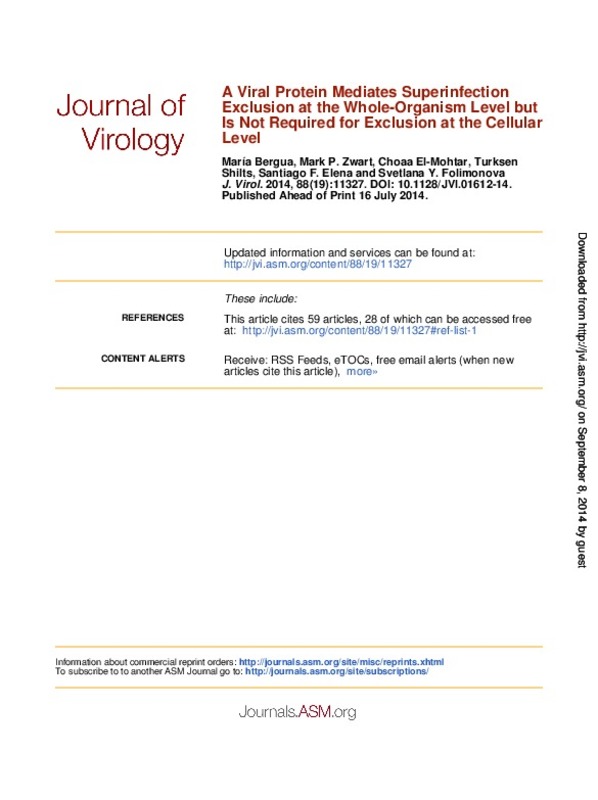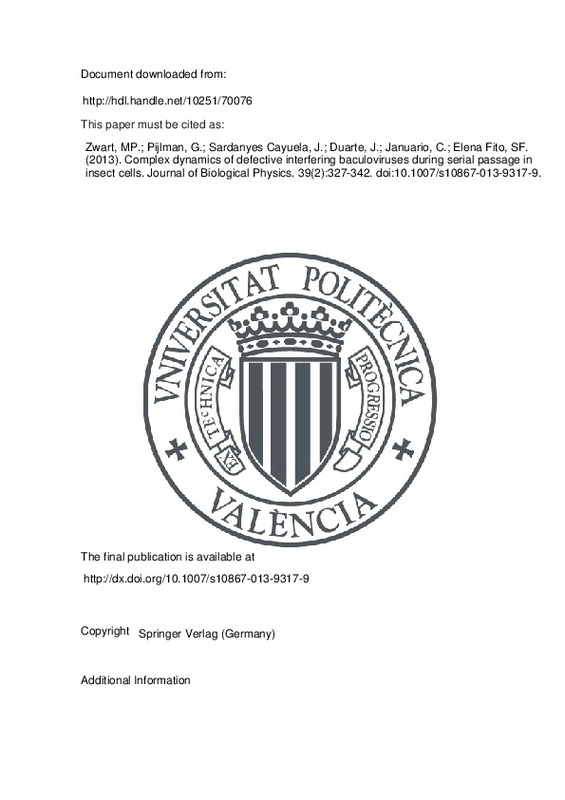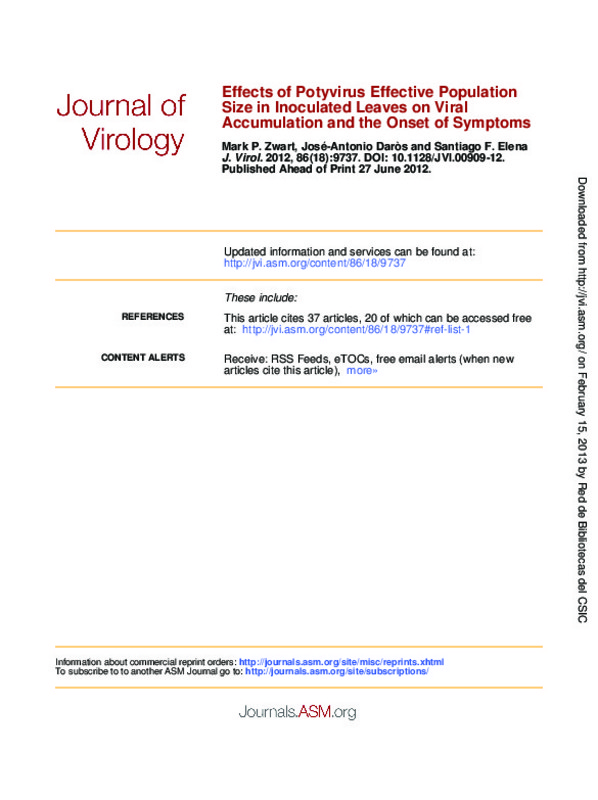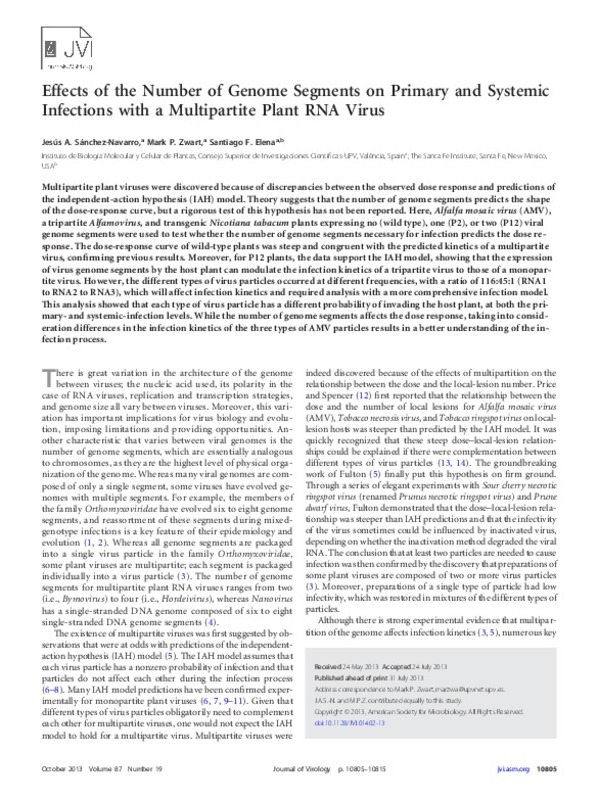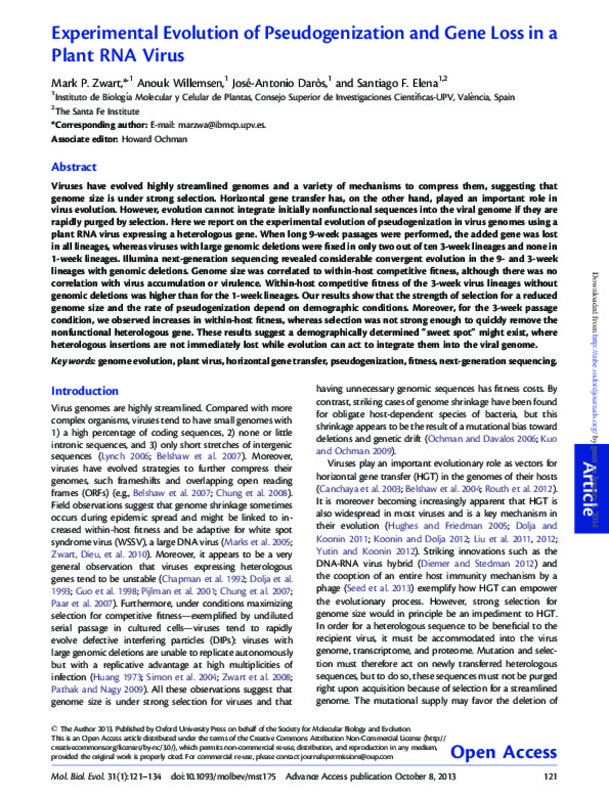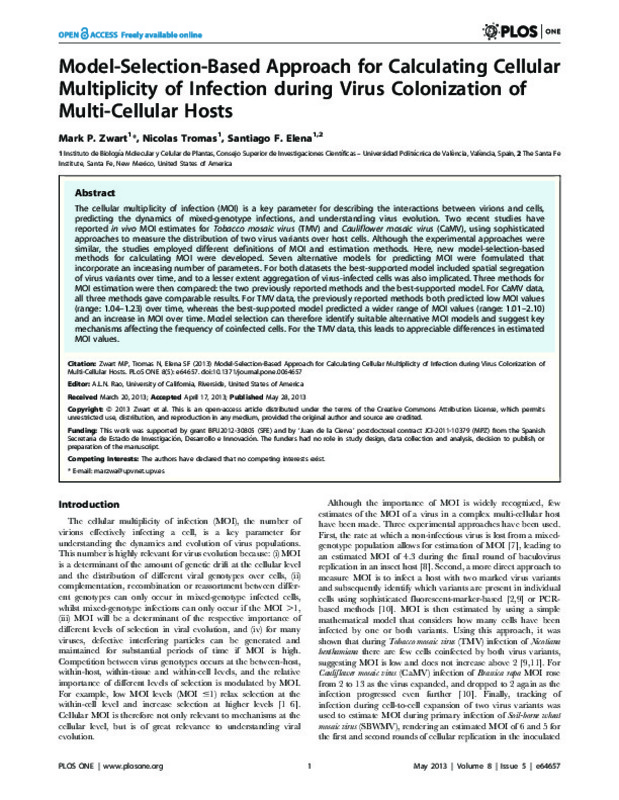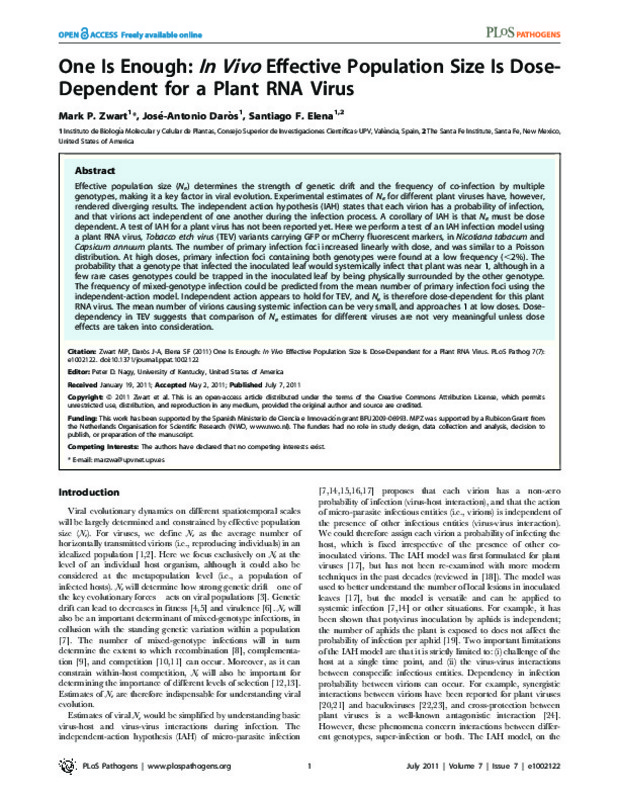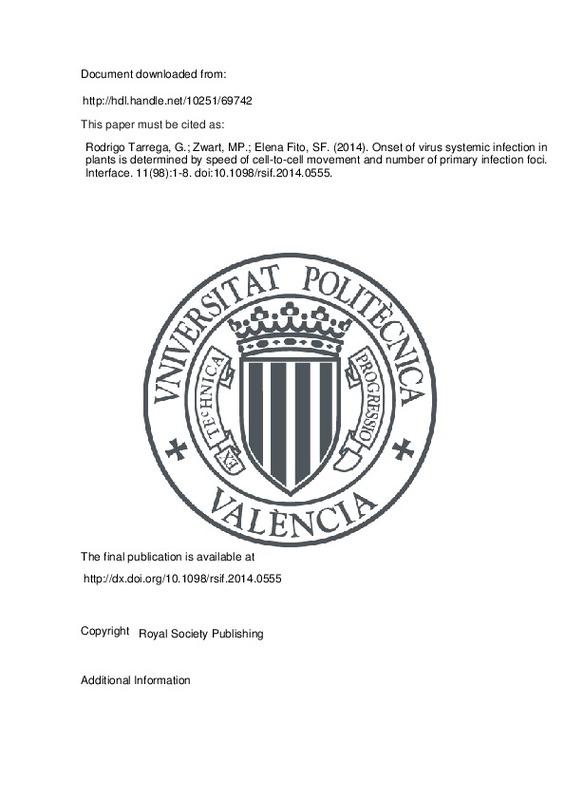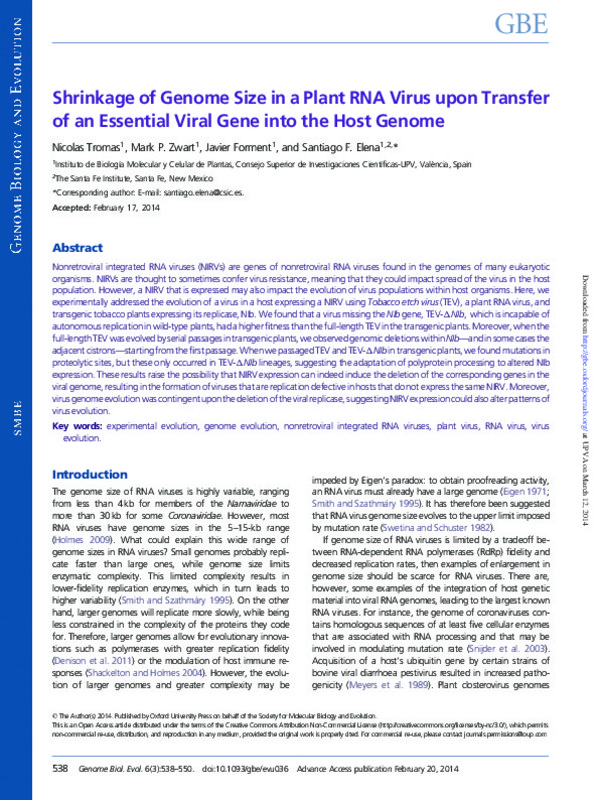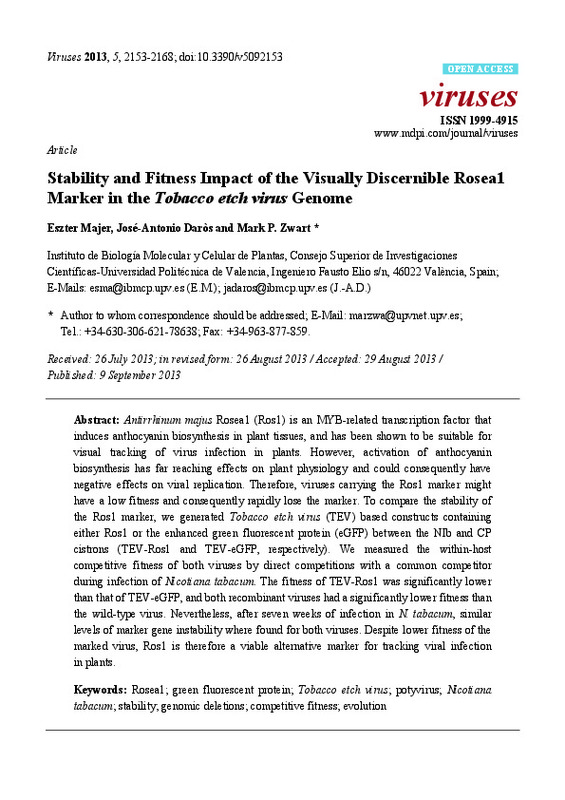

Listar por autor "Zwart, Mark Peter"
RiuNet: Repositorio Institucional de la Universidad Politécnica de Valencia
- RiuNet repositorio UPV
- :
- Listar por autor
JavaScript is disabled for your browser. Some features of this site may not work without it.
Buscar en RiuNet
Listar
Mi cuenta
Ayuda RiuNet
Admin. UPV
Listar por autor "Zwart, Mark Peter"
Mostrando ítems 1-18 de 18
-
Bergua, Maria; Zwart, Mark Peter; El-Mohtar, Choaa; Shilts, Turksen; Elena Fito, Santiago Fco; Folimonova, Svetlana Y. (American Society for Microbiology, 2014-10)[EN] Superinfection exclusion (SIE), the ability of an established virus infection to interfere with a secondary infection by the same or a closely related virus, has been described for different viruses, including important ...
-
Zwart, Mark Peter; Pijlman, G.P.; Sardanyes Cayuela, Jose; Duarte, J; Januario, C; Elena Fito, Santiago Fco (Springer Verlag (Germany), 2013-03)Defective interfering (DI) viruses are thought to cause oscillations in virus levels, known as the 'Von Magnus effect'. Interference by DI viruses has been proposed to underlie these dynamics, although experimental tests ...
-
Lafforgue, Guillaume; Tromas, Nicolas; Elena Fito, Santiago Fco; Zwart, Mark Peter (American Society for Microbiology, 2012)[EN] In the clinic, farm, or field, for many viruses there is a high prevalence of mixed-genotype infections, indicating that multiple virions have initiated infection and that there can be multiple sites of primary infection ...
-
Zwart, Mark Peter; Daros Arnau, Jose Antonio; Elena Fito, Santiago Fco (American Society for Microbiology, 2012)[EN] Effective population size (N-e) is a key parameter for understanding evolutionary processes, but it is generally not considered in epidemiological studies or in studying infections of individual hosts. Whether Ne has ...
-
Sanchez Navarro, Jesus Angel; Zwart, Mark Peter; Elena Fito, Santiago Fco (American Society for Microbiology, 2013-10)[EN] Multipartite plant viruses were discovered because of discrepancies between the observed dose response and predictions of the independent-action hypothesis (IAH) model. Theory suggests that the number of genome segments ...
-
Tromas, Nicolas; Zwart, Mark Peter; Poulain, Maite; Elena Fito, Santiago Fco (Microbiology Society, 2014)[EN] Phylogenomic evidence suggested that recombination is an important evolutionary force for potyviruses, one of the larger families of plant RNA viruses. However, mixed-genotype potyvirus infections are marked by low ...
-
Zwart, Mark Peter; Willemsen, Anouk; Daros Arnau, Jose Antonio; Elena Fito, Santiago Fco (Oxford University Press (OUP): Molecular Biology and Evolution, 2014-01)[EN] Viruses have evolved highly streamlined genomes and a variety of mechanisms to compress them, suggesting that genome size is under strong selection. Horizontal gene transfer has, on the other hand, played an important ...
-
Zwart, Mark Peter; Elena Fito, Santiago Fco (Annual Reviews, 2015)For virus infections of multicellular hosts, narrow genetic bottlenecks during transmission and within-host spread appear to be widespread. These bottlenecks will affect the maintenance of genetic variation in a virus ...
-
Zwart, Mark Peter; Tromas ., Nicolas; Elena Fito, Santiago Fco (Public Library of Science, 2013-05)The cellular multiplicity of infection (MOI) is a key parameter for describing the interactions between virions and cells, predicting the dynamics of mixed-genotype infections, and understanding virus evolution. Two recent ...
-
Zwart, Mark Peter; Daros Arnau, Jose Antonio; Elena Fito, Santiago Fco (Public Library of Science, 2011)[EN] Effective population size (N-e) determines the strength of genetic drift and the frequency of co-infection by multiple genotypes, making it a key factor in viral evolution. Experimental estimates of N-e for different ...
-
Rodrigo Tarrega, Guillermo; Zwart, Mark Peter; Elena Fito, Santiago Fco (Royal Society Publishing, 2014-09-06)The cornerstone of today's plant virology consists of deciphering the molecular and mechanistic basis of host-pathogen interactions. Among these interactions, the onset of systemic infection is a fundamental variable in ...
-
Willemsen, Anouk; Zwart, Mark Peter; Higueras, Pablo; Sardanyes Cayuela, Jose; Elena Fito, Santiago Fco (Oxford University Press (OUP), 2016-09)One of the striking features of many eukaryotes is the apparent amount of redundancy in coding and non-coding elements of their genomes. Despite the possible evolutionary advantages, there are fewer examples of redundant ...
-
Majer, Eszter; Salvador, Zaira; Zwart, Mark Peter; Willemsen, Anouk; Elena Fito, Santiago Fco; Daros Arnau, Jose Antonio (American Society for Microbiology, 2014-04)[EN] Potyviruses express most of their proteins from a long open reading frame that is translated into a large polyprotein processed by three viral proteases. To understand the constraints on potyvirus genome organization, ...
-
Tromas, Nicolas; Zwart, Mark Peter; Forment Millet, José Javier; Elena Fito, Santiago Fco (Oxford University Press, 2014)[EN] Nonretroviral integrated RNA viruses (NIRVs) are genes of nonretroviral RNA viruses found in the genomes of many eukaryotic organisms. NIRVs are thought to sometimes confer virus resistance, meaning that they could ...
-
Majer, Eszter; Daros Arnau, Jose Antonio; Zwart, Mark Peter (MDPI, 2013-09)[EN] Antirrhinum majus Rosea1 (Ros1) is an MYB-related transcription factor that induces anthocyanin biosynthesis in plant tissues, and has been shown to be suitable for visual tracking of virus infection in plants. ...
-
Cuevas, Jose M.; Willemsen, A; Hillung, Julia; Zwart, Mark Peter; Elena Fito, Santiago Fco (Oxford University Press (OUP), 2015-05)[EN] Populations of plant RNA viruses are highly polymorphic in infected plants, which may allow rapid within-host evolution. To understand tobacco etch potyvirus (TEV) evolution, longitudinal samples from experimentally ...
-
Zwart, Mark Peter; Elena Fito, Santiago Fco (American Phytopathological Society, 2015-01)[EN] The independent action hypothesis is a simple model of pathogen infection that can make many useful predictions on infection kinetics and, therefore, a number of different tests of independent action have been developed. ...
-
Elena Fito, Santiago Fco; Bedhomme, Stephanie; Carrasco, Purificación; Cuevas, Jose M.; De la Iglesia Jordán, Francisca; Lafforgue, Guillaume; Lalic, Jasna; Prosper Pontones, Angels; Tromas, Nicolas; Zwart, Mark Peter (American Phytopathological Society, 2011-03)[EN] Over the years, agriculture across the world has been compromised by a succession of devastating epidemics caused by new viruses that spilled over from reservoir species or by new variants of classic viruses that ...
Mostrando ítems 1-18 de 18

Universitat Politècnica de València. Unidad de Documentación Científica de la Biblioteca (+34) 96 387 70 85 · RiuNet@bib.upv.es


